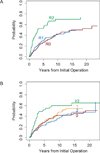Histology-based Classification Predicts Pattern of Recurrence and Improves Risk Stratification in Primary Retroperitoneal Sarcoma
- PMID: 25915910
- PMCID: PMC4619189
- DOI: 10.1097/SLA.0000000000001149
Histology-based Classification Predicts Pattern of Recurrence and Improves Risk Stratification in Primary Retroperitoneal Sarcoma
Abstract
Objective: To determine the prognostic significance of histologic type/subtype in a large series of patients with primary resected retroperitoneal sarcoma.
Background: The histologic diversity and rarity of retroperitoneal sarcoma has hampered the ability to predict patient outcome.
Methods: From a single-institution, prospective database, 675 patients treated surgically for primary, nonmetastatic retroperitoneal sarcoma during 1982 to 2010 were identified and histologic type/subtype was reviewed. Clinicopathologic variables were analyzed for association with disease-specific death (DSD), local recurrence (LR), and distant recurrence (DR).
Results: Median follow-up for survivors was 7.5 years. The predominant histologies were well-differentiated liposarcoma, dedifferentiated liposarcoma, and leiomyosarcoma. Five-year cumulative incidence of DSD was 31%, and factors independently associated with DSD were R2 resection, resection of 3 or more contiguous organs, and histologic type. Five-year cumulative incidence for LR was 39% and for DR was 24%. R1 resection, age, tumor size, and histologic type were independently associated with LR; size, resection of 3 or more organs, and histologic type were independently associated with DR. Liposarcoma and leiomyosarcoma were associated with late recurrence and DSD (as long as 15 years from diagnosis). For solitary fibrous tumor, LR was uncommon (<10%), but early distant recurrence was common (36% at 5 years). Nomograms were developed to predict DSD, LR, and DR.
Conclusions: Histologic type/subtype is the most important independent predictor of DSD, LR, and DR in primary retroperitoneal sarcoma. Histology predicts the pattern and incidence of LR and DR and will aid in more accurate patient counseling and selection of patients for adjuvant therapy trials.
Figures





References
-
- Singer S, Maki RG, O'Sullivan B. Soft Tissue Sarcoma. In: DeVita VT, Lawrence TS, Rosenberg SA, editors. Cancer: Principles & Practice of Oncology. Philadelphia, PA: Lippincott Williams & Wilkins; 2011. pp. 1533–1576.
-
- Thomas DM, O'Sullivan B, Gronchi A. Current concepts and future perspectives in retroperitoneal soft-tissue sarcoma management. Expert Rev Anticancer Ther. 2009;9:1145–1157. - PubMed
Publication types
MeSH terms
Grants and funding
LinkOut - more resources
Full Text Sources
Other Literature Sources
Medical

